If your air conditioner suddenly quits working, you might’ve heard that the dual run capacitor is to blame.
But what is the dual run capacitor, anyway? And what does the dual run capacitor do for your AC?
A dual run capacitor is a single component that contains two run capacitors. One capacitor helps run the AC compressor, and the other capacitor helps run the condenser fan motor.
In this article, I’ll go over everything you need to know about your AC’s dual run capacitor – including its location, ratings, what terminals it has, and how to test and wire your dual run capacitor.
What Does a Dual Run Capacitor Do?
A dual run capacitor helps your AC’s compressor and condenser fan motor turn on. If your dual run capacitor goes bad, then one or both of these components won’t turn on.
A dual run capacitor is actually two capacitors combined into a single package – one capacitor is for your compressor, and the other is for your condenser fan motor.
All AC condensing units have a compressor and condenser fan motor. So instead of installing two separate run capacitors, AC manufacturers install a single dual run capacitor to save space and simplify installation.
Where Is the Dual Run Capacitor Located?
The dual run capacitor is located inside your AC condenser unit’s control enclosure. Look for the metal cover on the side of your AC unit where the labels are – your dual run capacitor will be inside there.
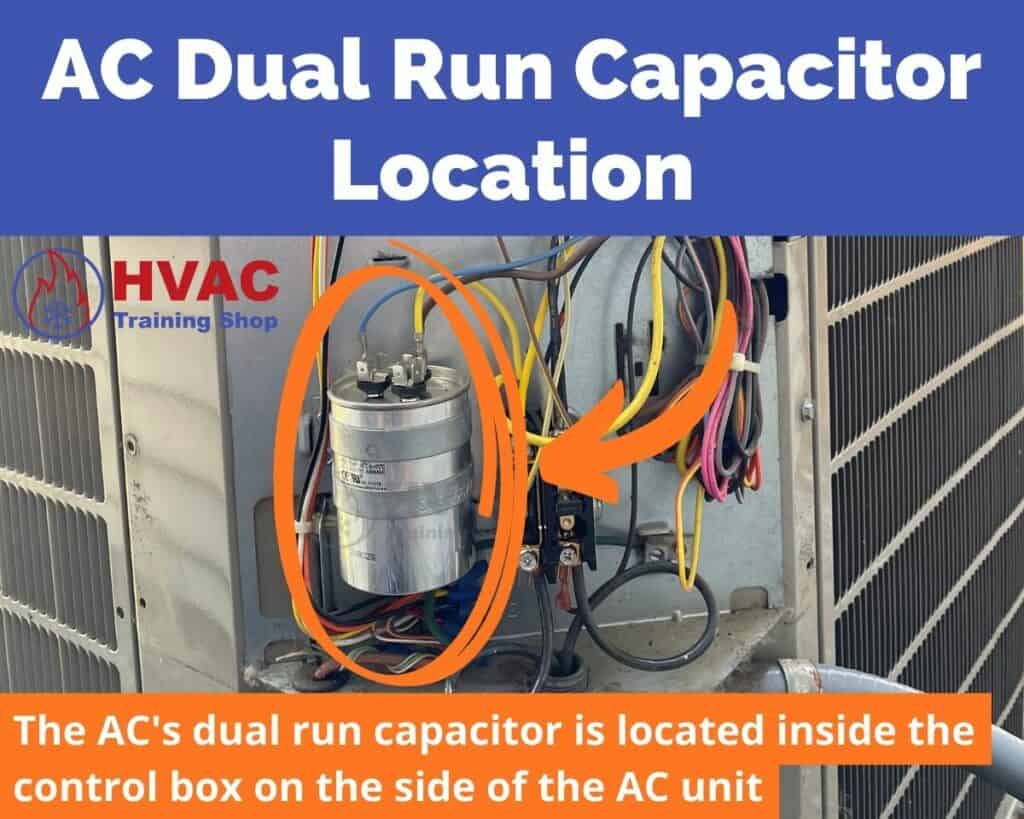
You’ll need to remove the enclosure’s metal cover to get inside the unit and access the dual run capacitor.
Caution! Be sure to turn off the power to your AC unit before opening up the control enclosure
After removing the cover for the control enclosure, you’ll find all sorts of wires and components. The dual run capacitor is almost always silver in color and oval or cylindrical in shape.
Dual Run Capacitor Ratings
All dual run capacitors have three ratings that you need to pay attention to:
- Herm microfarad (uF) rating
- Fan microfarad (uF) rating
- Voltage (VAC) rating
- Tolerance rating
I’ll go over them below.
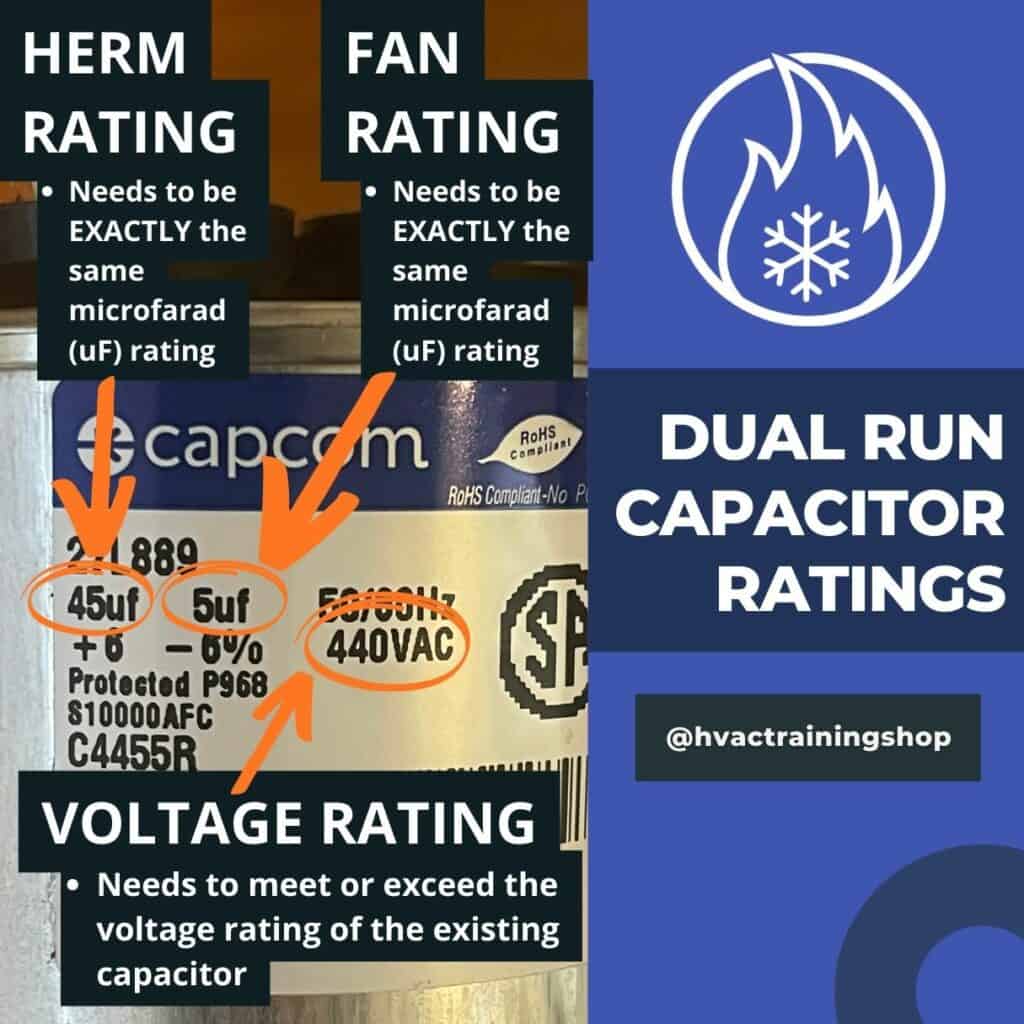
Dual Run Capacitor Capacitance (microfarad) Ratings
A dual-run capacitor has two capacitance ratings:
- The first, higher capacitance microfarad rating is for the Herm (Compressor) terminal
- The second, lower capacitance microfarad rating is for the Fan terminal
Dual run capacitor microfarad ratings will be denoted in one of the following ways:
- Using a slash (/) to separate the two microfarad ratings (for example, 45/5 uF)
- Using a plus (+) to separate the two microfarad ratings (for example, 45+5 uF)
- Printing the two microfarad ratings separately (for example, 45 uF 5 uF)
The microfarad rating is abbreviated in many different ways as well. uF, uf, μf, μF, mfd, and MFD all mean the same thing – microfarads.
When replacing an old capacitor, the capacitance ratings on the new capacitor must EXACTLY match the ones from the old capacitor.
For example, if your old capacitor was rated for 45/5 uF, then the new capacitor must have the same exact 45/5 uF rating.
Dual Run Capacitor Voltage Rating
A dual-run capacitor also has a voltage rating. The voltage rating is either 370 VAC or 440 VAC.
The voltage rating on your new capacitor needs to meet or exceed the voltage of the capacitor that you’re replacing.
For example, if your old capacitor is 370 VAC, then you can use either a 370 VAC or a 440 VAC capacitor to replace it.
But if your old capacitor is 440 VAC, then you must replace it with a 440 VAC capacitor.
Some dual run capacitors have two voltage ratings on them. For example, it might have 370/440 VAC printed on its label. This means that you can use the capacitor to replace either a 370 VAC or a 440 VAC capacitor.
Dual Run Capacitor Tolerance Rating
The tolerance rating on a dual run capacitor measures how far out of specification its microfarad rating can be and still be considered good.
For example, a typical tolerance rating on a dual run capacitor is +/- 6%. This means that as long as the capacitor measures within 6% of its microfarad rating, it is still considered within specification.
For example, a 45 microfarad capacitor can measure anywhere between 42.3 and 47.7 microfarads and still be considered good.
If you’re looking to purchase a new dual run capacitor, a tolerance of +/- 10% is the highest that I would go with.
What Happens if You Use a Capacitor With the Wrong Rating?
If you use a capacitor with the wrong capacitance rating, you will burn out the start winding in your condenser fan motor or compressor.
If your capacitor’s capacitance rating is not what the fan motor or compressor is designed for, your fan motor or compressor might run for a while – but it will experience increased wear and eventually burn out.
If you use a capacitor with a lower voltage rating than what is required, the capacitor will go bad and may cause damage to your AC compressor or condenser fan motor.
If your capacitor’s voltage rating is lower than what your fan motor or compressor is designed for, your capacitor’s dielectric fluid will break down, leading to a short circuit and failure of the capacitor.
What if You Don’t Know the Rating of the Old Capacitor?
If you’re replacing your existing dual run capacitor, you’ll need to match the capacitance rating and meet or exceed the voltage rating.
But what if you don’t know the rating of the old capacitor? How are you supposed to make sure that your new capacitor has the correct ratings?
Fortunately, the compressor and condenser fan motor both have their capacitance and voltage ratings printed on their nameplates.
Figuring out the capacitor ratings for the condenser fan is simple – you usually don’t even need to take apart the condenser.
If you look through the metal grate on the top of your condenser, you should be able to spot the nameplate on the side of the condenser fan motor.
The condenser fan motor’s nameplate has its capacitor ratings printed on it.
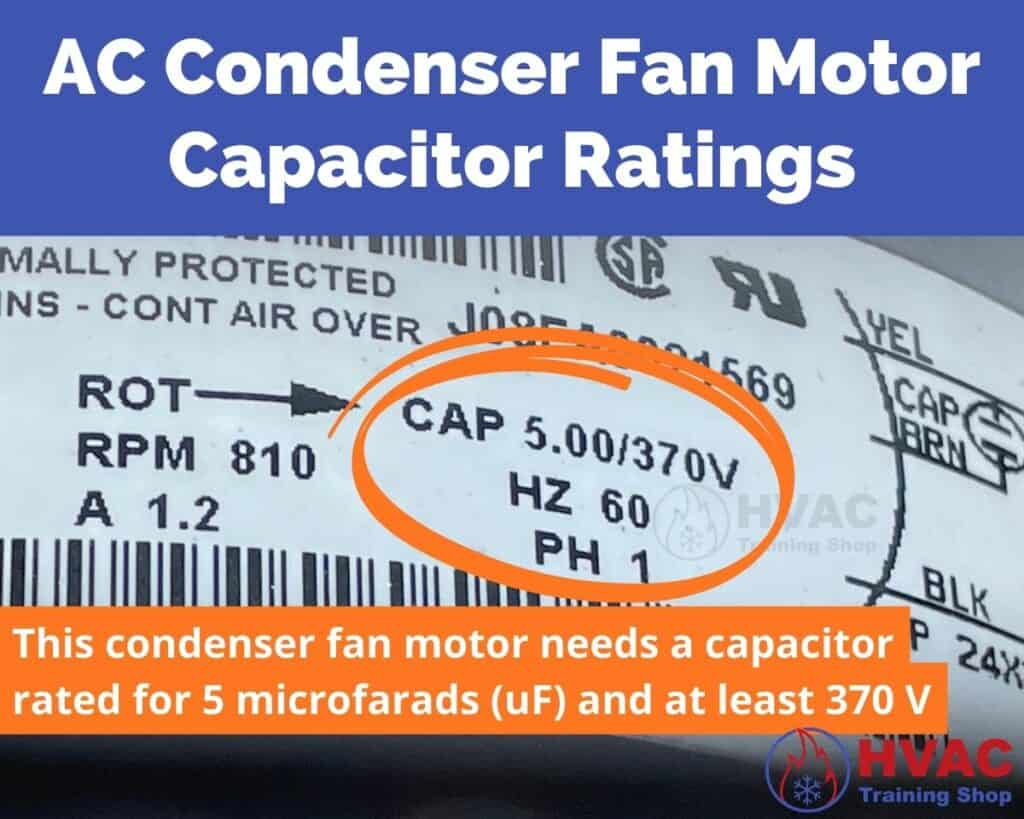
Finding the nameplate for a compressor is a little more complicated.
The compressor’s nameplate has its capacitor ratings printed on it.
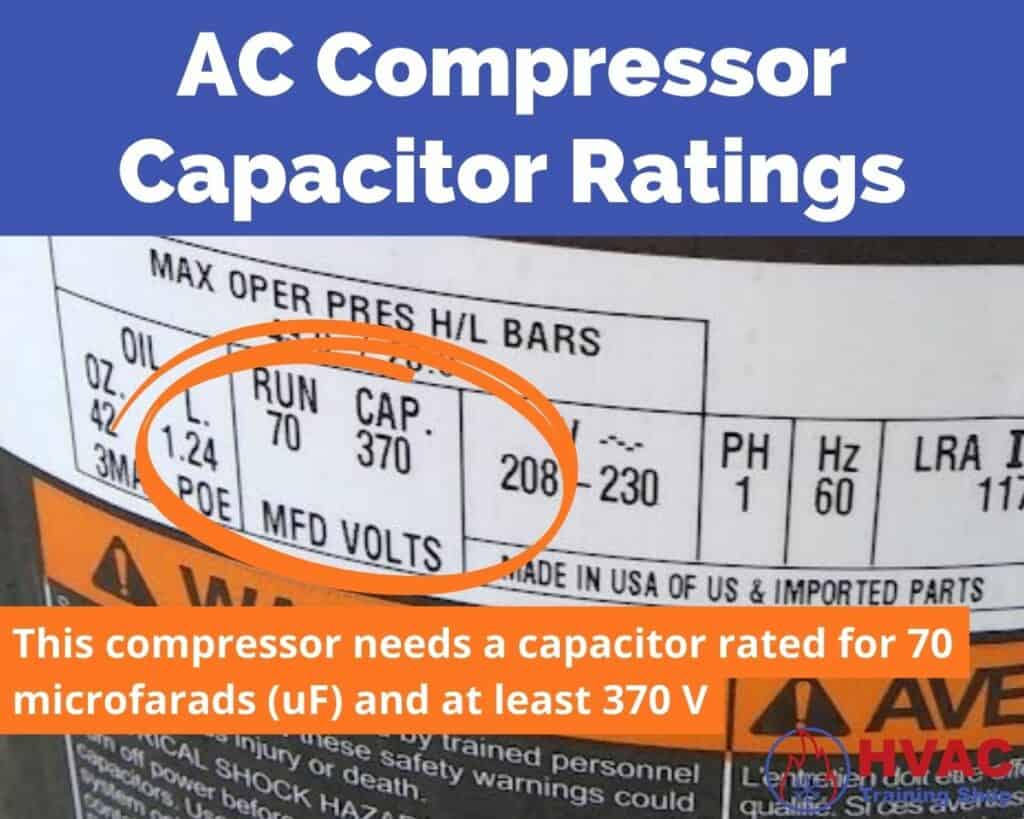
Since the compressor is usually attached to the bottom of the inside of the condenser, you might need to take the side panel off of your condensing unit to see its nameplate.
Some compressors also have a sound blanket over them to muffle the noise they make when they run. If your compressor is wrapped in a sound blanket, you’ll need to remove the blanket to read its capacitor ratings on its nameplate.
Dual Run Capacitor Terminals
There are three terminals on a dual run capacitor:
- COM or C – For the Common
- HERM – For the Hermetically Sealed Compressor
- FAN – For the Condenser Fan
However, there are some situations where you can’t read the labels on the terminals of your dual run capacitor – such as if the capacitor is rusty or damaged. Some capacitors don’t even have labels on their terminals at all!
In those cases, you can still figure out which terminal is which by counting the number of blades or tabs on the terminals:
- COM – 4 tabs
- HERM – 3 tabs
- FAN – 1 or 2 tabs
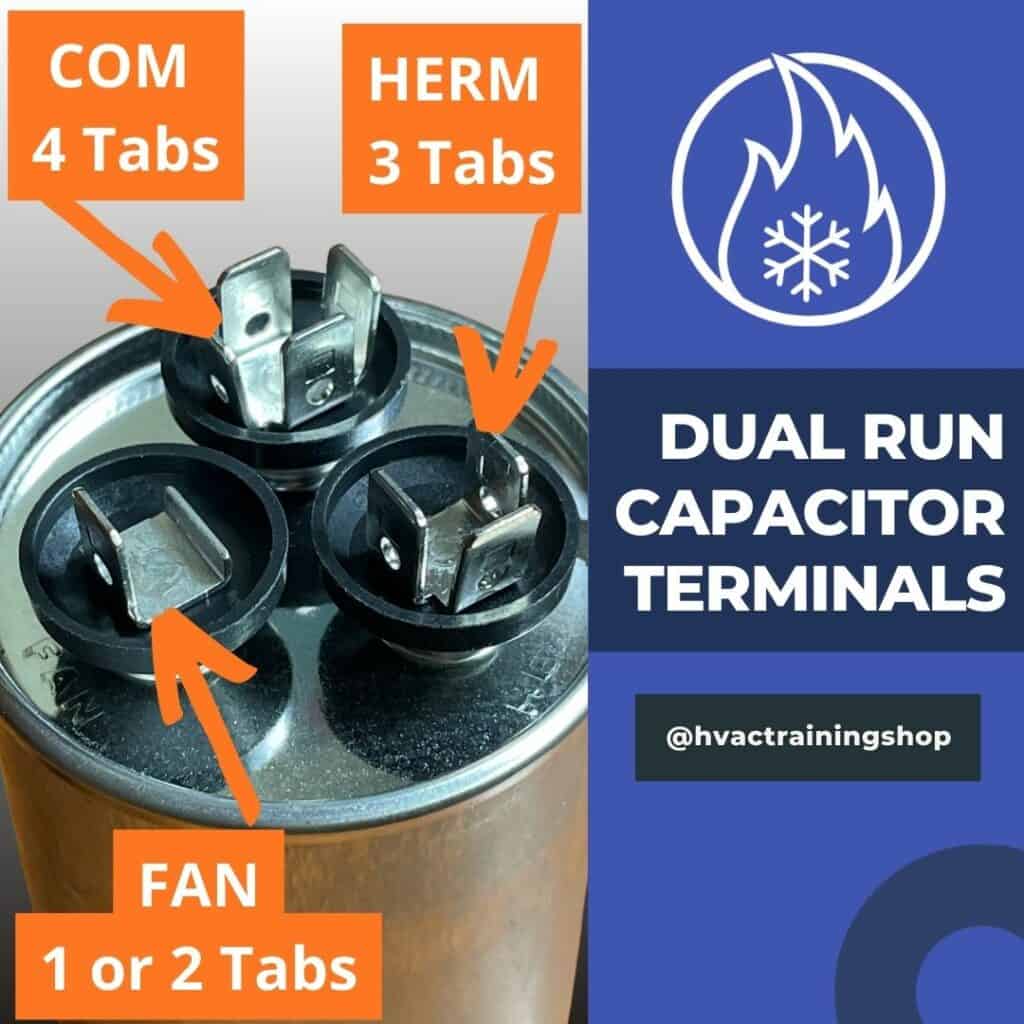
The number of tabs on each terminal varies slightly between different manufacturers of dual run capacitors.
Generally, the COM terminal will have the most amount of tabs, and the FAN terminal will have the least amount of tabs. The HERM terminal will have an amount of tabs somewhere in between.
How to Test a Dual Run Capacitor
To test a dual run capacitor, you need to disconnect it from your AC unit, discharge the capacitor, and then use a multimeter to test it.
Switch your multimeter to its capacitance testing setting and put the probes between the “COMMON” and “FAN” terminals to test the capacitance of the condenser fan side of the capacitor, as shown below.

Put the probes between the “COMMON” and “HERM” terminals to test the capacitance of the compressor side of the capacitor, as shown below.
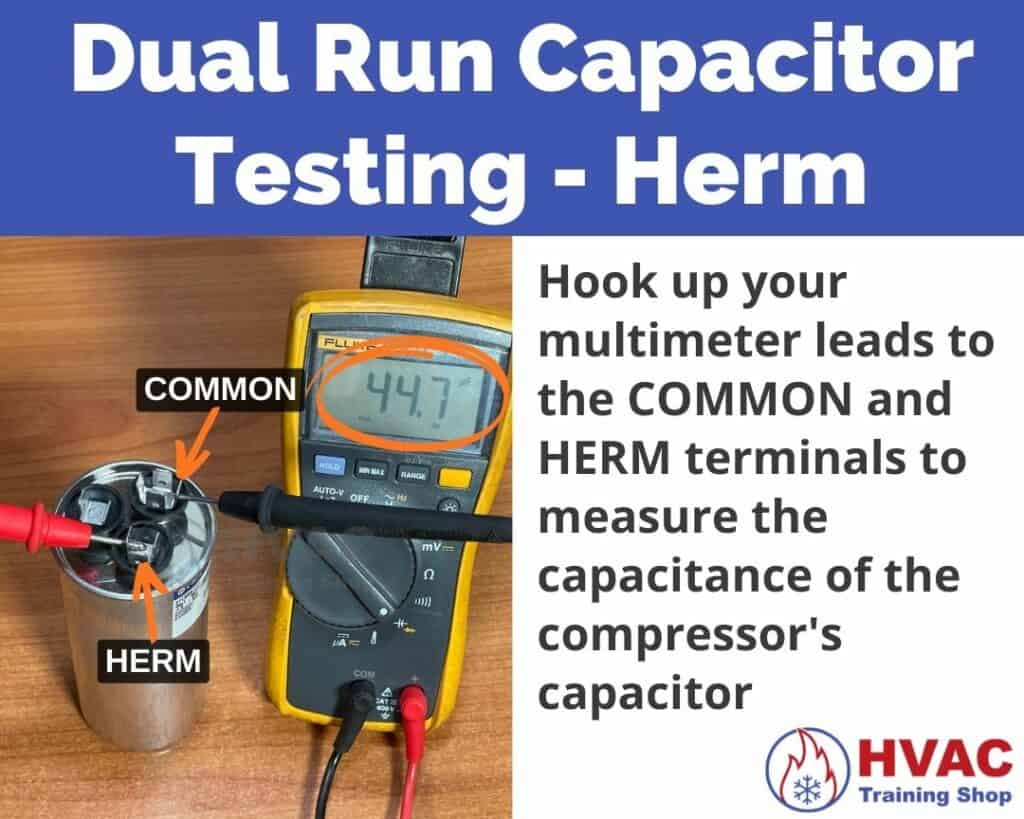
If your capacitor measures within 10% of its microfarad rating, then it is good. Anything that measures outside of 10% of the microfarad rating is around the threshold that you should replace the capacitor.
For example, if the herm terminal on your 45/5 microfarad capacitor measures 40 uF, then that’s 11.8% from its 45 uF rating, so the capacitor is bad and should be replaced.
How to Wire a Dual Run Capacitor
Wiring a dual run capacitor will be slightly different for every AC unit, but there are some general guidelines that you can follow in case you don’t know where each wire goes:
- HERM – Connects to the compressor start wire
- FAN – Connects to the condenser fan motor start wire
- COM – Connects to the run wires from the compressor and fan motor, and also to one of the input voltage terminals on the contactor


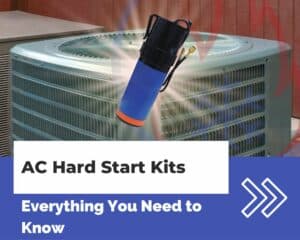
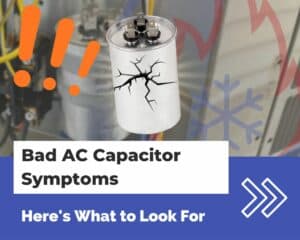
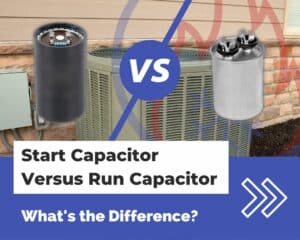
Thank you. Very well explained, and very nuch appreciated.
Thank you very much. This article is very helpful.
Question: My Trane A/C has both a dual run capacitor and a single run capacitor. What is the single run capacitor for?
Thanks,
Tom
Hi Tom,
I’m wondering if what you’re describing as a single run capacitor is a hard start kit?
Here’s an article I wrote about hard start kits: https://hvactrainingshop.com/ac-hard-start-kits/
Hope this helps,
-Trey
My AC fan does not turn on but was working alittle while ago,I opened up and looked at the capacitors,One duel and one single,The duel has 1 wire from hem and 2 wires coming from the common but no wires from the fan terminal.Thats not right.Can the single capacitor be running the fan and needing replace too.I am getting a reading 35.7 on the single and 5 on the duel withno reading when I touch the fan and common together.
Hi Robert,
Yeah, it seems the way the capacitors are wired that the dual capacitor is for the compressor and the single capacitor is for the fan. But your readings seem way off – it would make more sense if they were the other way around. What are the capacitors ratings?
-Trey
The capacitor I am replacing has a 5/35uf rating with a 10000 AFC NON PCB (Diversitech). One of the replacement capacitors I order (I think mistakenly) is a Climatek 35uf 5uf with no other information.
Would there be a difference between the Diversitech 5/35uf and Climatek 35uf 5uf. If so, what would be the expected result with the Climatek?
Hi Tom.
The farad ratings look fine.
The other things you need to pay attention to are the voltage (370 or 440) and tolerance (+/- %) ratings on each of the capacitors.
1. The replacement capacitor’s voltage (370 or 440V) rating should be the same or higher than the original one
2. The replacement capacitor’s tolerance (+/- %) rating should be equal to or lower than the original one
Hope this helps,
-Trey
Is the higher (35uf) for the herm or is the first rating listed for the herm(5uf)? I have a similar question for a friedrich unit that takes a 5/15 uf but all I can buy are 15/5 uf.
Hi John,
Herm will always be the higher uf rating
The compressor of my central aircon did not come on, but the fan was running. I called a HVAC technician, and he replaced the dual capacitor and added a hard start kit. He charged me for CAD300.- But these 2 parts do not cost more than CAD80.- at Amazon. Is it too much ?
I was not happy after that, and I visited many sites to research on the topic, and think that in future I will try to do it myself. Finally I arrived at your website and read your article. Very well written and comprehensive. Excellent, good job !
Hi Frank,
Thanks for your comment on the article!
I’m not sure of the average prices in your area, but CAD300 does not seem unreasonable for a technician to come to your home to replace a dual run capacitor and add a hard start kit. Keep in mind that the parts are only a perentage of the cost – the skilled labor makes up a large part of the cost of servicing an HVAC system, and so does the overhead of running a business.
Hope this helps,
-Trey
Not that it’s any of my business, but I would like to add, that CAD300 doesn’t seem unreasonable at at. I had to have just a run capacitor replaced and was charged over $300USD just for that. I didn’t complain though, he got the system up and running in no time.
The other thing Trey mentioned is experience. Not a lot of people realize, but capacitors will hold a charge long after the power has been disconnected… sometimes up to a year.. .and that voltage can still be LETHAL. It needs to be properly discharged before replacement, and even knowing this and watching my dad do it hundreds of times… I would rather pay a licensed HVAC technician to do the job.
The other issue is, not that it probably matters, but any work done on a unit will void it’s warranty.
My Goodman central aircon is 12 years old. If the compressor breaks down, which option is better – to replace the compressor or install a new aircon ? Normally, how long central aircon can last ?
Hi Frank,
The average lifespan of an air conditioning condensing unit is about 15-20 years. Sometimes less, sometimes more, it depends on many factors.
If a compressor breaks down and the condensing unit is approaching its end of life, its generally wiser to get a whole new unit rather than just replacing the compressor. It will cost more, but you’ll have the peace of mind knowing that you have an entire new unit, rather than an old unit with a new compressor where something else could go wrong again a few months down the road.
-Trey
Thank you very much, Trey.
Maybe I got lucky, but we had a Carrier central A/C installed in our NJ house in 1988, and it was still running strong when we sold the house in 2019. Throughout the 31 years, we never had a problem with it, and didn’t even have any annual service or maintenance performed. Never spent a single cent on it after initial installation. Curious to know others’ experience.
Quick question. I am replacing my run capacitor. I have found one with all of the same numbers (old is 35/7.5 voltage is 440 and 50/60 hz) The only difference is the old is +/-10% and the replacement is +/-6%. is this ok
Hi Warren,
Yes, using the capacitor with a +/- 6% rating is ok.
The +/- 10% means that the capacitor ratings are within a tolerance of 10%. For example, since your capacitor is 35/7.5, then the capacitance should be between within 10% of its rating, so between 31.5 to 38.5 microfarads for the herm and 6.75 to 8.25 microfarads for the fan.
A +/- 6% means that the capacitor has a stricter tolerance – which is better. Your capacitor should measure even closer to its specified ratings. So between 32.9 to 37.1 microfarads for the herm and 7.05 to 7.95 microfarads for the fan.
Hope this helps,
-Trey
There seems to be a slight difference between the diagram and the writeup. Per the writeup there should be 3 wires connected to COM but there is only one in the diagram.
Also, why is it called a run capacitor if it connects only to the start terminals, and not the run terminals, on the fan and compressor?
Hi Mike,
The 3 wires are landed on L2 of the contactor instead of capacitor in the diagram. If you move the 2 yellow wires from L2 on the contactor to COM on the capacitor, the circuit is exactly the same.
The run capacitor connects to the start windings of the fan and compressor. The naming of the parts is just what they’re referred to in the industry.